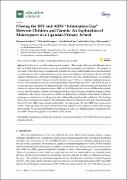| dc.contributor.author | Kendrick, Maureen | |
| dc.contributor.author | Namazzi, Elizabeth | |
| dc.contributor.author | Becker-Zayas, Ava | |
| dc.contributor.author | Tibwamulala, Nancy Esther | |
| dc.date.accessioned | 2021-04-26T15:46:49Z | |
| dc.date.available | 2021-04-26T15:46:49Z | |
| dc.date.issued | 2020-07-23 | |
| dc.identifier.citation | Kendrick, M., Namazzi, E., Becker-Zayas, A. and Tibwamulala, E.N., 2020. Closing the HIV and AIDS “Information Gap” Between Children and Parents: An Exploration of Makerspaces in a Ugandan Primary School. Education Sciences, 10(8), p.193. | en_US |
| dc.identifier.issn | 2227-7102 | |
| dc.identifier.uri | http://hdl.handle.net/20.500.12280/2752 | |
| dc.description.abstract | In this study, we address the research question: “How might child-created billboards about HIV and AIDS help facilitate more open discussions between parents and children?” The premise of our study is that there may be considerable potential for using multimodal forms of representation in makerspaces with young children to create more open dialogue with parents about culturally sensitive information. Drawing on multimodal literacies and visual methodologies, we designed a makerspace in a grade 5 classroom (with students aged 9–10) in a Ugandan residential primary school. Our makerspace included soliciting students’ knowledge about HIV and AIDS as part of a class discussion focused on billboards in the local community and providing art materials for students to explore their understandings of HIV and AIDS through the creation of billboards as public service announcements. Parents were engaged in the work as audience members during a public exhibition at the school. Data sources include the billboards as artifacts, observations within the makerspace, and interviews with parents and children following the public exhibition. The findings show that, for parents and children, the billboards enhanced communication; new understandings
about HIV and AIDS were gained; and real-life concerns about HIV and AIDS were made more visible. Although these more open conversations may depend to some degree on family relationships more broadly, we see great potential for makerspaces to serve as a starting point for closing the HIV and AIDS information gap between children and parents. | en_US |
| dc.language.iso | en | en_US |
| dc.publisher | MDPI | en_US |
| dc.relation.ispartofseries | Education Sciences;10(8) | |
| dc.subject | Makerspaces | en_US |
| dc.subject | Multimodal literacies | en_US |
| dc.subject | Visual methodologies | en_US |
| dc.subject | HIV/AIDS education | en_US |
| dc.subject | Uganda | en_US |
| dc.subject | Primary schools | en_US |
| dc.title | Closing the HIV and AIDS “Information Gap” Between Children and Parents: An Exploration of Makerspaces in a Ugandan Primary School | en_US |
| dc.type | Article | en_US |


